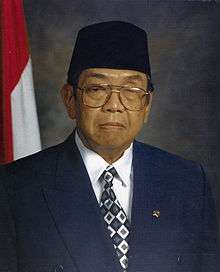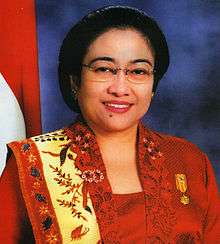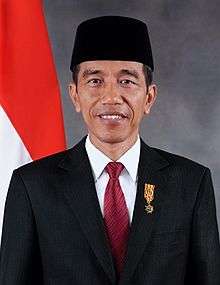List of Presidents of Indonesia
 |
| This article is part of a series on the politics and government of Indonesia |
| Pancasila (national philosophy) |
| Constitution |
|
Executive |
| Foreign relations |
This is a complete list of Presidents of Indonesia. The presidency was established during the formulation of the 1945 constitution by the Committee for Preparatory Work for Indonesian Independence (BPUPKI), a research body for the preparation of Indonesian independence. On 18 August 1945, the Preparatory Committee for Indonesian Independence (PPKI), which was created on 7 August to replace BPUPKI, selected Sukarno as the country's first president.
List of Presidents
| # | Portrait | Name (Birth–Death) |
Term of Office | Political Party | Vice President(s) | ||
|---|---|---|---|---|---|---|---|
| 1 |  |
Sukarno (1901–1970) |
18 August 1945 | 12 March 1967[1] | Non-Partisan | Mohammad Hatta | |
| vacant (1956–1973) | |||||||
| The first President of Indonesia. Declared Indonesia's independence from the Netherlands. Presided during the Indonesian National Revolution and the Dutch–Indonesian Round Table Conference. One of the founding fathers of the Non-Aligned Movement and hosted the 1955 Bandung Conference. Called for a 'Guided Democracy' amid the collapse of 10 governments during the 1950s, with Nasakom as the principle ideology. Acceded Western New Guinea. Opposed the formation of Malaysia and began Konfrontasi. Passed Supersemar in 1966, following the assassination of 6 generals. Relieved from power in 1967. | |||||||
| 2 |  |
Suharto (1921–2008) |
12 March 1967 | 21 May 1998 | Golkar with military support | Sri Sultan Hamengkubuwono IX | |
| Adam Malik | |||||||
| Umar Wirahadikusumah | |||||||
| Sudharmono | |||||||
| Try Sutrisno | |||||||
| Bacharuddin Jusuf Habibie | |||||||
| The second President of Indonesia. Seized power from Sukarno through Supersemar in 1966. Declared a New Order. Military dictatorships. Dismantled the Indonesian Communist Party and oversaw the mass murder and imprisonment of thousands of suspected communists throughout the archipelago. Ended Konfrontasi and initiated friendly relationships with neighbouring countries of Malaysia and Singapore, and Indonesia became a founding member of the Association of Southeast Asian Nations and the Asia-Pacific Economic Cooperation. Severed ties with China and other communist countries in the region. Annexed East Timor. Incorporated Western New Guinea into Indonesia. Oversaw great economic and infrastructural development, but rampant corruption within the bureaucracy and government. Resigned following the collapse of the Indonesian economy during the 1997 Asian financial crisis and the 1998 riots. | |||||||
| 3 |  |
Bacharuddin Jusuf Habibie (1936–) |
21 May 1998 | 20 October 1999 | Golkar | vacant | |
| The third President of Indonesia. First president who hailed from outside of Java. Took power following Suharto's resignation. Oversaw Indonesia's democratic transition. East Timor declared independence from Indonesia. Released thousands of political prisoners. Decided not to run for a full term. | |||||||
| 4 |  |
Abdurrahman Wahid (1940–2009) |
20 October 1999 | 23 July 2001 | National Awakening Party | Megawati Sukarnoputri | |
| 1999 – 54.37% | |||||||
| The fourth President of Indonesia. Head of Nahdlatul Ulama. First democratically elected president of Indonesia. Term embroiled by a number of scandals and corruption cases. Abolished all remaining legal discrimination against Chinese Indonesians. Attempts to reform the military and remove its political power were not taken kindly by military actors. Attempted to dissolve parliament, but was eventually impeached by parliament. | |||||||
| 5 |  |
Megawati Sukarnoputri (1947–) |
23 July 2001 | 20 October 2004 | Indonesian Democratic Party of Struggle | Hamzah Haz | |
| The fifth President of Indonesia and the first female President of Indonesia. Daughter of Sukarno. Came to power following the impeachment of Abdurrahman Wahid. Presided during a period of economic growth. Bali was attacked by a major bombing in 2002 by Jemaah Islamiyah. Lost the 2004 Presidential election to her former Coordinating Minister of Politics and Security. | |||||||
| 6 |  |
Susilo Bambang Yudhoyono (1949–) |
20 October 2004 | 20 October 2014 | Democratic Party | Jusuf Kalla | |
| Boediono | |||||||
| 2004 – 60.62% 2009 – 60.80% | |||||||
| The sixth President of Indonesia and the first president to be elected through a direct election. Parts of Sumatra were devastated by the 2004 Indian Ocean earthquake and tsunami. Jemaah Islamiyah severely weakened following efforts by Detachment 88. Indonesia classified part of MINT and became a member of the G-20. Elected to a second term in 2009. Indonesia formed the Bali Democracy Forum and became a founding member of the Open Government Partnership. Presided over consistent economic growth. Became the first president to address both houses of the Australian Parliament. During his second term, the Democratic Party suffered a number of corruption scandals. | |||||||
| 7 |  |
Joko Widodo (1961–) |
20 October 2014 | Incumbent | Indonesian Democratic Party of Struggle | Jusuf Kalla | |
| 2014 – 53.15% | |||||||
| The seventh President of Indonesia and the first not to have emerged from the country’s political elite or to have been an army general.[2] | |||||||
See also
- Governor-General of the Dutch East Indies
- President of Indonesia
- Vice President of Indonesia
- First Spouse of Indonesia
Footnotes
- ↑ Sukarno transferred key presidential powers to Suharto on 11 March 1966 in a vaguely worded letter of authority known as Supersemar but he was not formally relieved of his presidential title by the Indonesian parliament until March 1967.
- ↑ Joko Widodo, Populist Governor, Is Named Winner in Indonesian Presidential Vote, New York Times, 22 July 2014
This article is issued from Wikipedia - version of the 10/20/2016. The text is available under the Creative Commons Attribution/Share Alike but additional terms may apply for the media files.